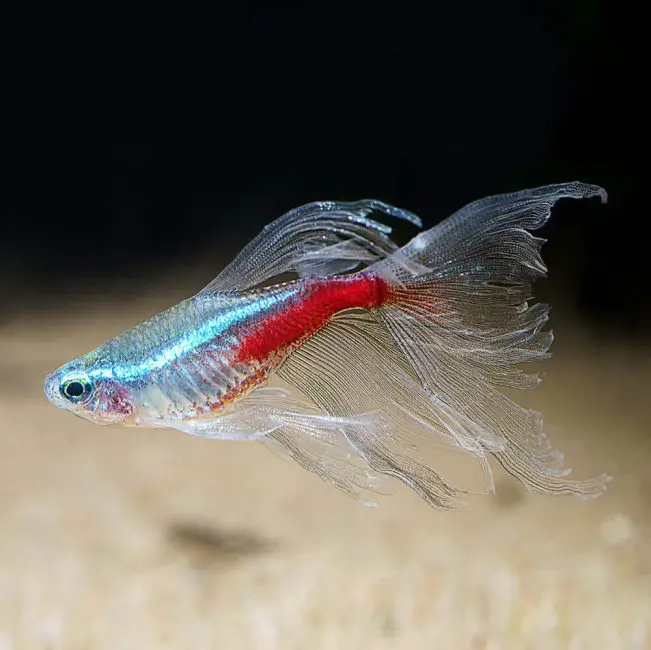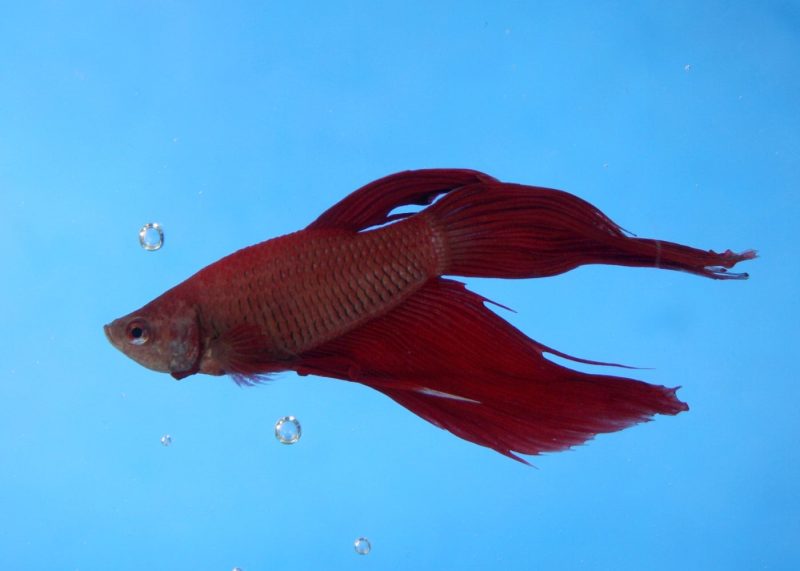In 2019, researchers exploring a remote highland river system in Southeast Asia encountered an extraordinary and previously undocumented species of freshwater fish. With elongated pectoral fins and the unusual ability to swim powerfully against fast-flowing currents, this long-finned fish captured scientific attention not only for its physical adaptations but also for its potentially unique evolutionary lineage. Still unnamed and under study, the species represents a breakthrough in our understanding of freshwater biodiversity and fish locomotion in high-energy stream environments.

The Discovery: A Remote Highland Encounter
Surveying Unexplored Streams
In the summer of 2019, a team of field biologists set out on a daring expedition into the highland interior of a mountainous region veiled in dense forest and mist. Their mission: to explore the aquatic life hidden within a network of remote upland streams—waterways that wind through steep ravines and thick jungle canopies, virtually untouched by modern science. These rivers, coursing through the skeleton of ancient geology, are shaped by gravity and rainfall, forming narrow, fast-flowing arteries with turbulent flows, jagged boulders, and sharply dropping gradients.
Accessing the river basin required trekking through tangled undergrowth, crossing slippery sandstone ledges, and camping beside roaring streams fed by monsoon rains. The scientific team, equipped with waterproof field gear, nets, and portable lab equipment, descended into the gorge to reach sampling stations that had likely never been visited by biologists. The water was icy, fast-moving, and stained tea-brown from leaf tannins—ideal habitat for rheophilic species, but challenging terrain for both humans and equipment.
An Unexpected Sight
During a late-afternoon drift net session, as sunlight filtered dimly through the canopy and fog clung to the hillsides, the researchers pulled up a mesh bag writhing with small riverine fish. Among the more familiar species, one specimen stood out instantly. Slender, luminous, and almost metallic in sheen, the fish bore exaggerated, wing-like pectoral fins that stretched far beyond its body’s midline, fluttering in the air like delicate veils. Its morphology was unlike anything previously recorded in the region’s freshwater fauna.
When placed in a clear flow chamber for observation, the fish revealed something even more astonishing. Rather than drifting passively like other fish in the same current, it actively fought the water’s force—maintaining a stable upstream position through rapid, rhythmic undulations of its elongated fins. It didn’t just resist the current—it appeared to glide against it, as if flying underwater. This behavior, rare among small freshwater fish and never before documented in this context, immediately captivated the team. Cameras rolled, specimens were preserved, and field notes overflowed with sketches and observations.
That evening, beneath a sky streaked with mist and the hum of nocturnal insects, the scientists gathered around their temporary camp to discuss what they had seen. The long-finned swimmer wasn’t just an oddity—it could be a new species, perhaps even a new genus, adapted for a life few fish could survive. It was a moment of quiet awe, one that reminded them all why the most inaccessible corners of nature still hold the brightest secrets.
Physical Characteristics of the Long-Finned Fish

Morphology and Adaptations
Sleek, streamlined, and unmistakably adapted for life in swift waters, the newly discovered long-finned fish stretches between 12 and 15 centimeters in length—small in stature but remarkable in form. Its body takes on a classic torpedo-like shape, sculpted for minimal resistance as it moves through turbulent stream currents. Every anatomical feature, from head to tail, seems tailored for hydrodynamic precision.
The most arresting aspect of its morphology is its elongated pectoral fins, which extend far beyond the usual boundaries seen in riverine fish. These fins are delicate yet muscular, with a fine, filamentous structure that evokes the wings of an insect or the trailing feathers of a bird in flight. In motion, they sweep rhythmically back and forth in synchronized undulations, not unlike the wingbeats of a gliding kestrel. Rather than acting as passive stabilizers, these fins appear to provide both lift and thrust, allowing the fish to hover in place or surge forward with minimal effort, even in water moving swiftly over submerged rocks.
Supporting this unique fin structure is a highly muscular caudal peduncle—the tapered section leading to the tail—which serves as a powerful engine for burst swimming when rapid escape is necessary. Its pelvic fins are stout and downward-facing, suggesting a secondary role in stabilization, acting almost like landing gear as the fish maneuvers along submerged surfaces. The scales are reduced and embedded within the skin, likely minimizing drag and abrasion in the rock-strewn current. The mouth is ventrally positioned and crescent-shaped, indicating a bottom-feeding lifestyle, with dietary preferences leaning toward benthic invertebrates, diatoms, and filamentous algae that cling to rocks in high-flow environments.
Comparison to Known Species
At first glance, the long-finned fish shares certain traits with members of the Balitoridae (hillstream loaches) and Gastromyzontidae, two families of rheophilic fish that have independently evolved adhesive fins and flattened bodies for navigating rapids. Like them, the long-finned fish is well-equipped for holding station in strong current. However, deeper anatomical examination—particularly of the pectoral girdle, fin musculature, and cranial structure—has revealed a suite of novel skeletal arrangements and soft-tissue adaptations not seen in those lineages.
Preliminary morphometric and osteological data suggest that this fish does not comfortably fit within any described genus. Notably, the base of the pectoral fin contains an unusual array of fin rays and supporting bones, hinting at a highly specialized evolutionary trajectory. The presence of airfoil-like musculature along the fin base is particularly rare in small freshwater species, suggesting this adaptation may have arisen in response to microhabitat conditions unique to its upland stream environment.
Because of these unique features, taxonomists working with the original specimens have proposed that the fish may represent not only a new species, but potentially a new genus—or even an entirely new family within the order Cypriniformes or a closely related clade. Genetic barcoding and whole-genome sequencing are currently underway to determine its phylogenetic placement with greater precision.
Behavioral Traits: Swimming Against the Current
Upstream Locomotion
Among the most striking behavioral features of this long-finned fish is its unwavering display of positive rheotaxis—the instinctive drive to orient and move against the direction of flowing water. While many freshwater fish exhibit this behavior temporarily, such as during upstream migrations to spawning grounds, this species engages in it continuously, suggesting it is not merely a phase-specific trait, but a permanent aspect of its ecological lifestyle.
In both natural stream habitats and experimental flow tanks, the fish consistently positioned itself head-first into the current, navigating with remarkable stability through even the most forceful torrents. What made this behavior especially unusual was the grace and efficiency with which it executed these maneuvers. Rather than simply bracing itself or anchoring against the substrate, the fish used aerodynamic fin motion—its long pectorals undulating in controlled, rhythmic arcs—to maintain buoyancy, orientation, and directional control.
Observers described its movement as “underwater gliding,” more akin to the flight of a bird in headwinds than to the darting, start-stop behavior typical of stream-dwelling fish. Even when startled, the fish did not flee downstream as many species do. Instead, it instinctively accelerated upstream, fighting both gravity and flow, disappearing into narrow crevices or deeper eddies where turbulence was greatest—habitats few fish can inhabit safely.
Possible Ecological Roles
The evolutionary function of this unusual locomotion pattern likely stems from a suite of interconnected ecological pressures. First and foremost, maintaining a position in fast-flowing water may provide access to high-oxygen zones, which are crucial in shallow, warm rivers where oxygen levels fluctuate seasonally. This behavior may also help the fish monopolize high-quality feeding grounds along upstream-facing rock surfaces where benthic algae and invertebrates accumulate.
In addition, upstream swimming may serve as a predator avoidance strategy. In narrow headwater streams, many ambush predators attack from downstream or rely on current-assisted pursuit. By remaining upstream and moving into turbulent microhabitats, the fish reduces its vulnerability to such threats. The ability to escape into the flow, rather than with it, may provide a unique survival advantage in an environment where current direction shapes both risk and refuge.
Another possible role involves reproductive ecology. In many stream-dwelling species, upstream movement is tied to spawning, particularly in systems with vertical barriers, fluctuating flow regimes, and limited breeding grounds. It is conceivable that this fish engages in upstream migration to reach elevated spawning areas that are seasonally inundated. Its extraordinary fin control could allow it to traverse waterfalls, rapids, or narrow channels where other fish would fail.
Finally, the fish’s persistent engagement with high-flow zones might reduce intraspecific competition. By exploiting physical niches that are energetically inaccessible to most other species, it may carve out a unique role in the ecosystem—feeding, breeding, and hiding in places where few rivals can follow.
In sum, the long-finned fish’s upstream locomotion is not simply a curiosity—it is a finely tuned behavioral adaptation that allows it to thrive in one of the most energetically demanding freshwater environments on Earth.
Evolutionary and Ecological Significance
A Specialized Freshwater Niche
The long-finned fish stands as a vivid example of extreme ecological specialization, honed by evolutionary pressures unique to highland stream environments. In these fast-flowing, oxygen-rich rivers—where water carves its way through steep ravines and shelter is scarce—only organisms with precise physiological and behavioral adaptations can persist. The fish’s elongated, wing-like fins, streamlined body, and unwavering upstream locomotion suggest not just an adjustment to flow, but a complete evolutionary commitment to a habitat few others can tolerate.
Such adaptations likely evolved through intense selective filtering, where only those individuals capable of withstanding hydraulic force, navigating slippery substrates, and exploiting narrow ecological windows survived to reproduce. Over generations, this pressure would refine anatomical features—such as fin length, musculature, and skeletal articulation—into the highly specialized configuration observed today.
These traits may also represent a case of convergent evolution, a phenomenon where unrelated species independently develop similar adaptations to meet the demands of comparable environments. Much like marine flying fish or Himalayan torrent frogs, this long-finned swimmer seems to have developed structural and behavioral innovations that parallel those of other rheophilic organisms across the globe—despite having no direct evolutionary link to them. Such convergence underscores the predictable power of environmental constraints in shaping evolutionary outcomes.
Insights into Stream Biodiversity
Beyond its anatomical novelty, the discovery of this fish offers important clues about the hidden biodiversity of upland stream systems—ecosystems that are often neglected in conservation and biodiversity research. Unlike wide, navigable rivers or picturesque mountain lakes, these headwaters are difficult to access, ephemeral in nature, and rarely prioritized for ecological surveys. Yet they are precisely the kinds of habitats where micro-endemism flourishes.
In regions with complex topography and climatic variability—such as Southeast Asia’s highlands—streams can become natural evolutionary laboratories, isolating populations and accelerating genetic divergence. Minor differences in water chemistry, temperature, or substrate can produce dramatic evolutionary outcomes over relatively short geological timescales. As a result, these habitats frequently harbor organisms with narrow ranges, cryptic behaviors, and unique morphological traits, many of which remain undocumented by science.
The long-finned fish, found in a single stretch of unprotected upland river, may be just one of many such species awaiting discovery in the world’s high-gradient freshwater networks. Its emergence from obscurity serves as both a scientific revelation and a conservation warning: without focused exploration and habitat protection, we risk losing entire evolutionary lineages before we even know they exist.
Conservation Challenges and Urgency
Habitat at Risk
The highland stream that harbors the long-finned fish may appear pristine to the naked eye—cool, clear, and shaded by ancient canopy—but beneath its surface lies a fragile equilibrium increasingly disrupted by human activity. Though isolated, these upland systems are far from immune to ecological degradation. Expanding deforestation in surrounding catchments introduces sediment and sunlight into previously shaded waters, altering flow patterns and temperature regimes. Agricultural runoff carries fertilizers, pesticides, and organic pollutants downstream, shifting nutrient balances and disrupting aquatic food webs. Perhaps most perilous is the growing push for hydropower development, which threatens to fragment river networks, modify current velocity, and eliminate seasonal flow pulses vital to reproductive cycles.
For a species as specialized and site-bound as the long-finned fish, even minor environmental changes can prove catastrophic. Its ability to hold position in strong current, feed on specific benthic resources, and possibly migrate upstream to spawn depends on a finely tuned set of hydrological conditions. Disrupt those variables—by silting up substrate, raising water temperature, or dampening flow—and the fish’s niche could collapse.
Adding to the urgency is the species’ lack of formal scientific description. Without a name, without a taxonomic identity, it remains invisible in the eyes of international conservation frameworks. No legal protections apply, no assessments can be made under IUCN criteria, and no funding is allocated for its preservation. Yet its evident site fidelity, narrow range, and extreme morphological specialization all signal a high degree of ecological vulnerability. In conservation biology, such unrecognized species are known as “silent extinctions”—organisms that disappear before they are ever known to exist.
The Need for Continued Research
Safeguarding this fish—and the riverine world it represents—will require more than reactive conservation. It demands proactive scientific investment and landscape-scale planning. This begins with completing the formal taxonomic process: describing the species, identifying its phylogenetic relationships, and publishing its ecological parameters. Only then can it be considered in regional conservation strategies and environmental policy decisions.
Simultaneously, integrated watershed management must be prioritized. That means protecting riparian zones with native vegetation, regulating land use to minimize runoff, and conducting rigorous environmental impact assessments before approving hydropower or infrastructure projects. These interventions not only preserve habitat for the long-finned fish but also maintain water quality and ecological function for entire aquatic communities.
Most importantly, the discovery of this fish should serve as a wake-up call: that even in remote, fast-flowing headwaters—places long thought resilient by virtue of their remoteness—biodiversity is both precious and precarious. Without immediate, targeted action, we risk losing not just a species, but a suite of evolutionary solutions forged in one of the most dynamic freshwater environments on Earth.
Future Directions in Study
Taxonomy and Genetics
With the long-finned fish still awaiting formal classification, one of the most pressing priorities is to unravel its taxonomic identity and evolutionary history. Current investigations involve detailed morphological dissections, focusing on skeletal structures, fin articulation, and soft-tissue specializations. Particular attention is being paid to the configuration of the pectoral girdle and musculature, which may hold key diagnostic traits distinguishing this fish from all known taxa.
In parallel, researchers are conducting genomic sequencing to place the species within the broader phylogenetic tree. Early molecular markers suggest a distant relationship with Cypriniformes, but its deep genetic divergence and unique anatomical features may warrant the designation of a new genus—or even a new family. If confirmed, this would represent a rare addition to the known diversity of rheophilic fishes and would help clarify how evolutionary pressures shape morphology in fast-flow environments. Genomic tools may also uncover adaptive gene clusters related to fin morphology, flow resistance, and oxygen metabolism—traits critical to survival in its niche.
Ecophysiology and Biomechanics
Beyond taxonomy, the fish’s extraordinary mode of locomotion offers a window into the intersection of biology and physics. Researchers are employing high-speed videography and computational fluid dynamics to model how its long pectoral fins interact with turbulent water. Unlike most riverine fish that resist current through body bracing or fin adhesion, this species appears to generate lift and forward thrust through undulatory fin motion, akin to underwater flight. By mapping the vortex patterns and pressure fields generated by its fins, scientists hope to extract principles that could inform biomimetic design in aquatic robotics, especially for machines operating in high-flow environments.
In addition, studies are underway to explore the fish’s respiratory physiology. Maintaining high levels of metabolic function while suspended in cold, fast-flowing water demands extraordinary efficiency in oxygen uptake. Researchers aim to measure gill surface area, blood oxygen affinity, and ventilatory capacity to understand how this fish copes with the dual challenges of velocity and low-temperature hydrology. These insights could prove critical as climate change accelerates shifts in freshwater flow regimes, putting new stress on species already living at the edge of physical tolerance.
Ultimately, the long-finned fish is more than just a taxonomic puzzle or a locomotory marvel—it is a living experiment in evolutionary innovation, and each new piece of data reveals how life can shape itself to thrive in Earth’s most demanding aquatic landscapes.
Conclusion
The long-finned fish found swimming upstream in a foggy, fast-moving stream system stands as a symbol of how much remains undiscovered in the world’s freshwater ecosystems. With its extraordinary morphology and behavior, this unnamed species adds to a growing body of evidence that riverine biodiversity is both richer and more complex than once assumed.
Its discovery underscores the importance of field exploration, taxonomic documentation, and urgent conservation. As environmental pressures mount, each new species we identify may be our only opportunity to learn from it—before the currents of change carry it out of reach.






